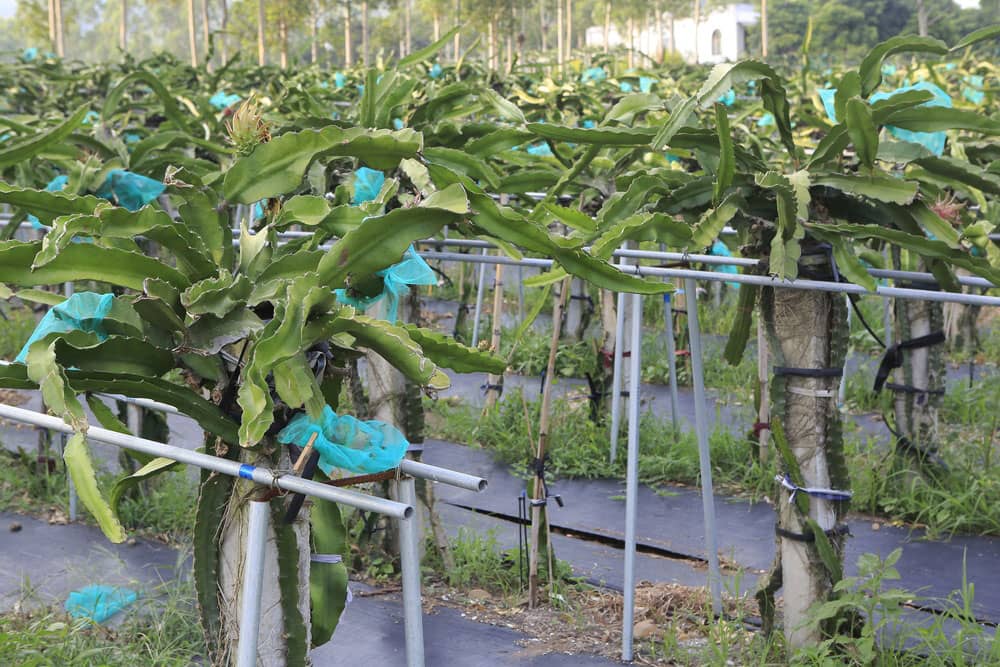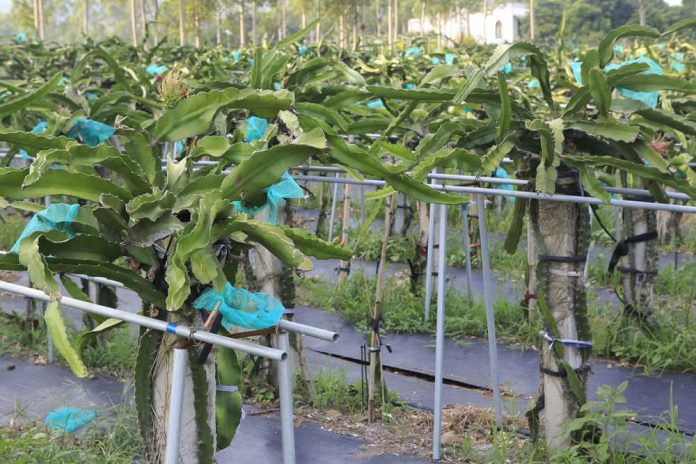Are you interested in dragon fruit farming? This post summarizes how you can grow dragon fruit in your garden and on the field.
Dragon fruit is an exotic cactus that is found in Asia, Mexico, and parts of South America. Another name for dragon fruit is Pitaya, it looks strange in appearance. The plant can be successfully grown were rainfall is less. Other names of dragon fruits are; cactus fruit, Jesus in the cradle, Night blooming Cereus, Strawberry pear, Belle of the Night etc.
Dragon fruit is planted as ornamental plants by some people for environmental purpose, but they do bare delicious fruit that is tasty. The fruit is used in jams, ice cream, fruit juice, Jelly production and wine. It flowers in April, while the fruit developing stage is July-August and harvesting of fruit is in December.
The blooms of dragon fruit are out standing, they are one of the largest flowers you can ever think of in the world. Their uniqueness is drawn from the fact that the blooms open only in a night and then the scent that comes out of it is so natural and fruity.
No matter the kind of dragon fruit variety you are growing the fruit will remain green until it ripens. When ripe can be bright yellow or red in colour. The pulp inside the fruit are filled with small seeds that look similar to those that are found in a kiwi fruit.
DRAGON FRUIT VARIETIES
The are three major types of dragon fruit, they are differentiated according to their outer and internal side colour:
Hylocereus Megalanthus
This type of dragon fruit has a white fruit flesh and a yellow shell. The shell variation is a bit thornier than the rest of the variations. It is rare to see them in the garden, they can also be called Selenicereus megalanthus, Pitaya amarillaor yellow pitahaya.
Hylocereus Undatus
This is a variation that has the same white flesh, but the exterior of this fruit is red in color. Pink colour fruit and a white colour flesh. It is also called Pitaya blancaor white-fleshed pitahaya.
Hylocereus Costaricensis
This type of fruit is red in coloration on both the shell and in the flesh. The flesh is often a deep red coloration that looks almost unnatural or blood–like. Also known as Pitaya rojaor red-fleshed Pitaya or Hylocereus polyrhizus.
TIME OF PLANTING
The growing season for dragon fruit is dry season if you what to start dragon fruit farming start after the rains have ended. It will not grow the remaining days of the year, but when it grows, will be vigorous. Bloom is from July to October, but it happens only one night every year, once the flowering has taken place fruit will start to form. Dragon fruit plant will continue to produce fruit for 20 to 30 years.

CLIMATE REQUIREMENT FOR DRAGON FRUIT FARMING
It requires an annual rainfall of 50cm and a temperature of 20C-30C. Externe sunlight is not conducive for dragon fruit growth in such cases you can use shade to protect them from high sunlight.
SOIL REQUIREMENT
Dragon fruit farming is best done in a well draining soil, it can be sandy-loam or sandy soil. It is grown on a slightly acidic soil with PH of 5.5-7.0. The soil should be rich in organic matter or has the nutrients requirement for optimum growth.
SITE SELECTION
Dragon fruit farming should be done in an open field with full exposure to direct sunlight. It should not be grown in regions where rainfall is well distributed.
LAND PREPARATION
Clear the land and remove every stump, raise mounds 300mm in rows, poles should be no more than 2m long with 600mm in the ground. Anything can be used for Poles from concrete to PVC, make sure you attach frame to the top to allow the plant hang down. Avoid using treated timber. Apply organic compost on the soil before planting in a proportional ratio.
PROPAGATION
Dragon Fruit can be planted through seed propagation or cuttings. The seed should be grown in a compost or potting soil that is mixed, the pot can also be placed indoors.
Dragon fruit cacti will germinate between 11 or 14 days after shallow planting. Since they are cacti, too much watering is a problem for home growers.
They are climbing plants as such as the keep growing will locate something to climb on, it will result in their putting down aerial roots from the branches together with the basal roots. As dragon fruit plant matures or reaches about 10 pounds in weight, it can then flower.
Cut the dragon fruit directly with knife and divide it into two parts. Remove the black seeds from the inner flesh and wash off pulp from the seeds. You can plant the seeds but it is not ideal for commercial dragon fruit farming because it takes a long time to germinate.
Cut 20cm length from the dragon fruit parent plant two days before planting. Put cut part in a pot filled with soil mixed with dry dung in a ratio of 1:2. Don’t expose the cut part to sunlight.
Dig a pit of 60cm x 60cm x60cm in size and plant them , fill the pit with 100g super phosphate compost.
Plant the cut dragon fruit plant in plastic bags for two months before transferring them to open field. Purchase the Cuttings from some local commercial nurseries and pitaya growers. You can get the Seedlings from seed companies or from commercial production. An acre will accommodate about 1500 dragon fruits.
TRANSPLANT/SPACING
Use a spacing of 3m (10 feet) for your dragon fruit farming. It will give enough room for watering, agronomical maintenance and harvesting. The distance chosen should be in line with the management approach you intend to use. If you will be using machines then adjust your spacing accordingly.
FERTILIZER APPLICATION
The recommended manure is a combination of organic fertilizer and complete fertilizer such as Urea (46-0-0). Make sure you Use more of organic and also more of nitrogen. Apply fertilizer every 3 months or every six months, the ideal application is to Use 2 kg of organic + 25g urea + 75g complete fertilizer on each plant.
Dragon fruit requires 10 to 15kg of organic compost or fertilizer for good vegetative growth. Organic fertilizer will help the plant to expand and grow.
IRRIGATION/MULCHING
Irrigate daily all through dry season at a volume of 80 liters per day, use drip irrigation if you can afford it or use watering can. Dig bore hole or well for watering before starting if there is no source of water then don’t bother going into dragon fruit farming. This is because Water stress can cause fruit splitting; slow down shoot development, yellowing and flower droppings.
Be sure to mulch your dragon fruit farm and maintain regular organic mulching”
PRUNING IN DRAGON FRUIT FARMING
Regularly prune your dragon fruit plant in other to obtain an open manageable and productive umbrella shape canopy. It is very important to prune the plant immediately after harvesting the fruits. When you regularly prune them’ it will induce new shoots for the next cropping season.
PEST/DISEASES
Meat ants, ginger ants, mites, aphids, thrips mealy bugs and birds are common pest that causes serious damage to plants and fruit. Use nets to prevent bird damage to fruit and pesticides.
Sunburn is a disease that causes a soft watery rot to occur after damage. Others are; cactus virus x’ Bipolaris cacti orca. Observe proper management. Plant healthy seedlings.

HARVESTING
The flowering is May-June and fruits from August-December. Dragon fruit starts bearing fruits after one year of planting. While the seedling takes 2 years or 26 months for dragon fruit plant to bear fruits after planting them in the field. After one month of flowering stage the fruits are ready for harvest.
Make sure you Harvest the fruits 35-40 days after flower opening. Immature dragon fruit has a bright green colour skin after some days the fruit skin turns red from dark green. The best time to harvest dragon fruit is 3-4 days after the fruit changes colour.
Dragon Fruit Yield
Use hand or sickle to pick the dragon fruit from the plant. Dragon fruit will yield 5 to 6 tones of the fruit for an acre on the average.
If this post was useful to you, Please follow us on Facebook and Twitter. Use the comment box for your questions and get a prompt response and don’t forget to subscribe to our newsletter below, just enter your name and email address.



Where can I get dragon plant seedlings?
call 08035965405, let me give the number I can’t drop it here
Very interesting love to have some dragon fruit plants in my farm. How can I get to plant in my farm?
CONTACT 08155196689